| Oracle® Fusion Middleware Administrator's Guide 11g Release 1 (11.1.1) Part Number E10105-13 |
|
|
PDF · Mobi · ePub |
| Oracle® Fusion Middleware Administrator's Guide 11g Release 1 (11.1.1) Part Number E10105-13 |
|
|
PDF · Mobi · ePub |
This chapter describes how to monitor Oracle Fusion Middleware using Fusion Middleware Control, Oracle WebLogic Server Administration Console, and the command line. It describes the following topics:
Note:
For information about monitoring servers for IBM WebSphere, see "Managing Oracle Fusion Middleware on IBM WebSphere" in the Oracle Fusion Middleware Third-Party Application Server Guide.
Monitoring the health of your Oracle Fusion Middleware environment and ensuring that it performs optimally is an important task for the administrator.
Oracle Fusion Middleware provides the following methods for monitoring the status of your environment:
Oracle WebLogic Server Administration Console: You can monitor the status of Oracle WebLogic Server domains, clusters, servers, Java components, and applications. From the Administration Console, navigate to the entity's page. See "Overview of the Administration Console" in the Oracle Fusion Middleware Introduction to Oracle WebLogic Server for information on monitoring using the console.
Fusion Middleware Control: You can monitor the status of Oracle WebLogic Server domains, clusters, servers, Java components, system components, and applications. Navigate to the entity's home page, for example, to the home page for an Oracle HTTP Server instance.
The command line: You can monitor the status of your environment using the WLST or opmnctl command lines.
To monitor the status of Java components, use the WLST state command, with the following format:
state(name, type)
For example, to get the status of the Managed Server server1, use the following command:
wls:/mydomain/serverConfig> state('server1','Server')
Current state of "server1": SUSPENDED
To monitor the status of system components, use the opmnctl status command, with the following format:
opmnctl status [scope] [options]
For example, to view the status of all processes monitored by OPMN, use the following command:
opmnctl status
Most of the monitoring tasks in this chapter describe how to monitor using Fusion Middleware Control or the command line.
The following topics provide more detail:
You can view the overall status of the Oracle Fusion Middleware environment from the home page of the farm using Fusion Middleware Control. This page lists the availability of all components, an application deployment summary, including SOA composites, if any SOA composite applications are deployed.
To view the overall status, from the navigation pane, select the farm.
The farm home page is displayed, as shown in the following figure:
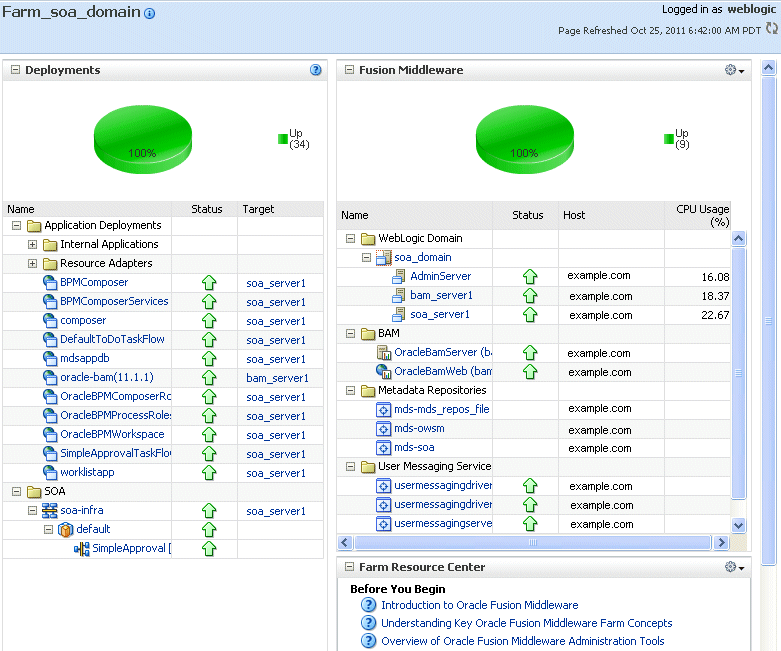
This page shows the following:
A list of deployed applications and the status of each
Lists of domains, the servers within the domains, metadata repositories, and other Oracle Fusion Middleware entities, with the status of each
A Resource Center with links to relevant documentation
You can view the status of a domain, including the servers, clusters, and deployments in the domain from the domain home page of Fusion Middleware Control:
From the navigation pane, expand the farm, then WebLogic Domain.
Select the domain.
The domain home page is displayed, as shown in the following figure:

This page shows the following:
A general summary of the domain, along with a link to the Oracle WebLogic Server Administration Console
Information about the servers, both the Administration Server and the Managed Servers, in the domain
Information about the clusters in the domain
Information about the deployments in the domain
A Resource Center, which provides links to more information
See Also:
"Overview of the Administration Console" in the Oracle Fusion Middleware Introduction to Oracle WebLogic Server for information about monitoring an Oracle WebLogic Server domain using the Oracle WebLogic Server Administration Console. The Administration Console provides details about the health and performance of the domain.
You can view the status of a WebLogic Server Administration Server or Managed Server in Fusion Middleware Control:
From the navigation pane, expand the farm, then WebLogic Domain, and then the domain.
Select the server.
The server home page is displayed.
The following figure shows the home page for a Managed Server:

This page shows the following:
A general summary of the server, including its state, and information about the servlets, JSPs, and EJBs running in the server
Response and load
Information about the applications deployed to the server
See Also:
"Overview of the Administration Console" in the Oracle Fusion Middleware Introduction to Oracle WebLogic Server for information about monitoring servers using the Oracle WebLogic Server Administration Console. The Administration Console provides details about the health and performance of the server.
You can view the status of a cluster, including the servers and deployments in the cluster using Fusion Middleware Control:
From the navigation pane, expand the farm, then WebLogic Domain, and then the domain.
Select the cluster.
The cluster page is displayed, as shown in the following figure:

This page shows the following:
A general summary of the cluster, including the broadcast channel, if appropriate, the load algorithm, and the messaging mode
A response and load section, which shows the requests per minute and the request processing time
A deployments section with information about the applications deployed to the cluster
A server section, with a table listing the servers that are part of the cluster
See Also:
"Overview of the Administration Console" in the Oracle Fusion Middleware Introduction to Oracle WebLogic Server for information about monitoring a cluster using Oracle WebLogic Server Administration Console. The Administration Console provides details about the health and performance of the cluster.
You can view the status of a Java component, including whether the component is started, in the component home page in Fusion Middleware Control.
To monitor a Java component, such as WebCenter Portal: Spaces:
From the navigation pane, expand the farm, then the type of component, such as WebCenter, then the component, such as Portal, then Spaces.
Select the component. For example, select the WebCenter Spaces instance.
The component home page is displayed, as shown in the following figure:
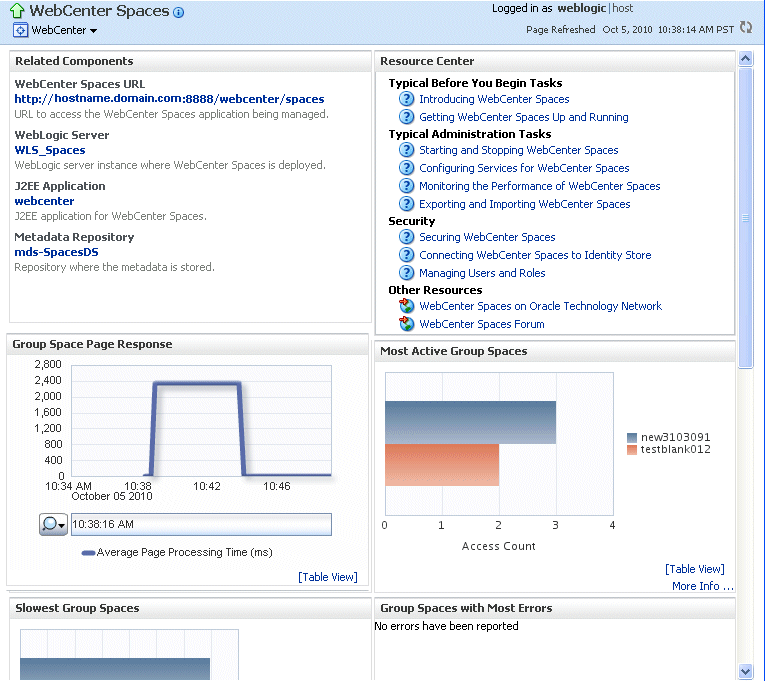
This page shows the following:
A list of related components
A Resource Center with links to relevant documentation
A chart showing the group space page response
A chart showing the most active group spaces
A chart showing the slowest group spaces
A chart showing the group spaces with the most errors
See Also:
"Overview of the Administration Console" in the Oracle Fusion Middleware Introduction to Oracle WebLogic Server for information about using the Oracle WebLogic Server Administration Console to monitor Java components
To monitor a system component, such as Oracle HTTP Server:
From the navigation pane, expand the farm, then Web Tier.
Select the component, such as ohs1.
The component home page is displayed, as shown in the following figure:
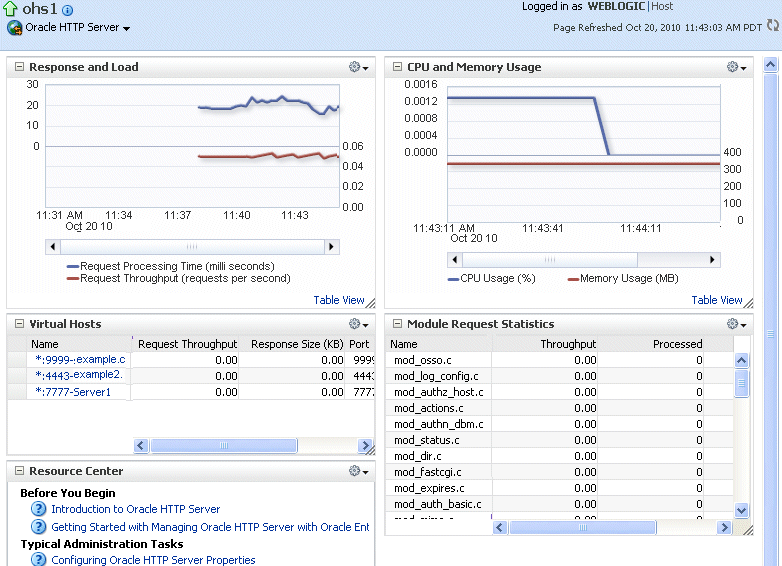
This page shows the following:
A response and load section, which shows the requests per second and the request processing time
CPU and memory usage
The virtual hosts, with their names, request throughput and response size.
Module request statistics, with a list of modules and the throughput for each.: A table listing the processing time for each module
A Resource Center with links to relevant documentation
To monitor a Java EE application using Fusion Middleware Control:
From the navigation pane, expand the farm, expand Application Deployments, then select the application to monitor.
The application's home page is displayed.
In this page, you can view a summary of the application's status, entry points to the application, Web services and modules associated with the application, and the response and load.
The following figure shows a portion of the application's home page:
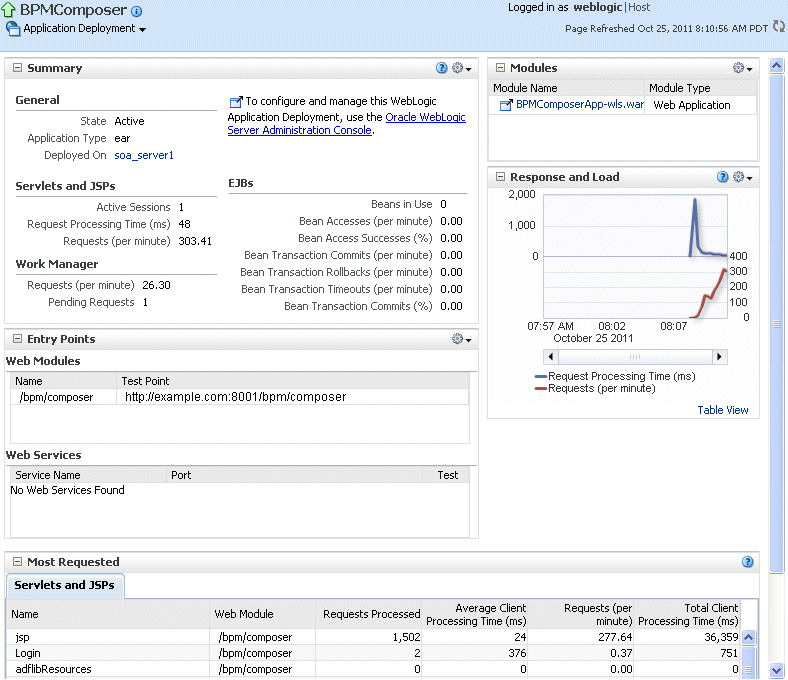
This page shows the following:
A summary of the application, including its state, the Managed Server on which it is deployed, and information about active sessions, active requests, and request processing time
Entry points, including any Web modules and Web services
A list of modules with the type of module for each
Response and load, which shows the requests per minute and the request processing time
A list of most requested servlets, JSPs, and Web services
To monitor an ADF application:
From the navigation pane, expand the farm, expand Application Deployments, then select the application to monitor.
The application's home page is displayed.
In this page, you can view a summary of the application's status, entry points to the application, Web services and modules associated with the application, and the response and load.
To monitor a SOA composite application:
From the navigation pane, expand the farm, expand SOA, then soa-infra. Select the application to monitor.
The application's home page is displayed.
From this page, you can monitor the running instances, faults and rejected messages, and component metrics.
The following figure shows part of a SOA composite home page:
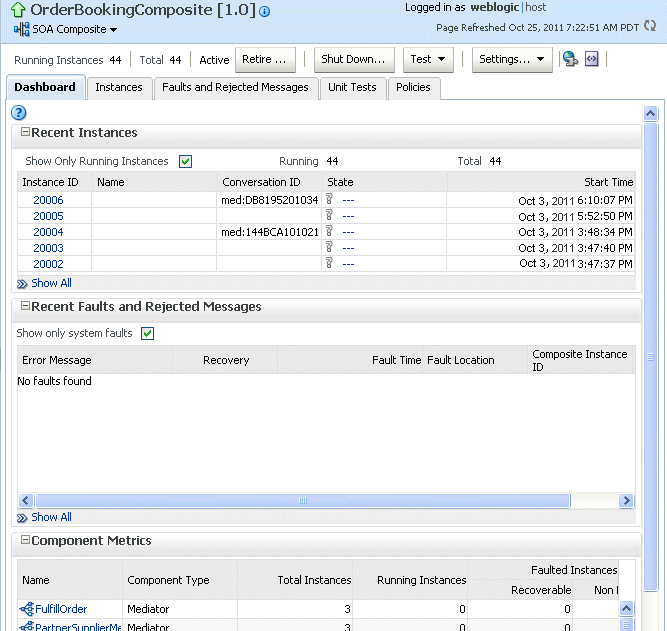
This page, with the Dashboard tab selected, shows the following:
The recent instances
Recent faults and rejected messages
Component metrics
To monitor an Oracle WebCenter Portal application:
From the navigation pane, expand the farm, expand Application Deployments, then select the application to monitor.
The application's home page is displayed.
In this page, you can view a summary of the application's status, entry points to the application, Web services and modules associated with the application, and the response and load.
For some applications, you can view service metrics. From the Application Deployment menu, choose Web Center, then Service Metrics.
The following figure shows the Service Metrics page:
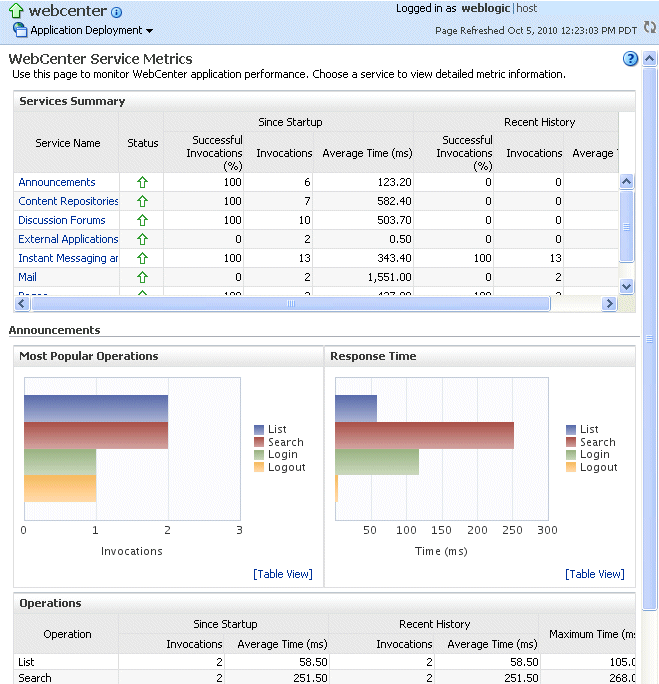
This page shows the following:
A summary of WebCenter Service metrics, with the status and invocations for each service.
A chart showing the most popular operations,
A chart showing response time for the different types of operations
An Operations section that shows the operations since startup and recent operations
See Also:
"Understanding WebCenter Portal Performance Metrics" in Oracle Fusion Middleware Administrator's Guide for Oracle WebCenter Portal for more information about service metrics
If you deploy an application to a cluster, Oracle Fusion Middleware automatically deploys the application to each Managed Server in the cluster. As a result, there is an instance of the application on each server.
There are times when you want to monitor the performance of the application on an individual server, and times when you want to monitor the overall performance of the application across all the servers in the cluster.
For example, normally, you would manage the overall performance of the application to determine if there are any performance issues affecting all users of the application, regardless of which instance users access. If you notice a performance problem, you can then drill down to a specific instance of the application to determine if the problem is affecting one or all of the application instances in the cluster.
Fusion Middleware Control provides monitoring pages for both of these scenarios:
From the navigation pane, expand the farm, expand Application Deployments.
Fusion Middleware lists the applications deployed in the current domain.
If an application has been deployed to a cluster, Fusion Middleware Control shows a plus sign (+) next to the application to indicate that it represents more than one instance of the application on the cluster.
Expand the cluster application to show each instance of the application, as shown in the following figure:

Monitor the overall performance of the application on the cluster by clicking the cluster application, or monitor the performance of the application on a single server by clicking one of the application deployment instances.
If you encounter a problem, such as an application that is running slowly or is hanging, you can view more detailed performance information, including performance metrics for a particular target, to find out more information about the problem.
Oracle Fusion Middleware automatically and continuously measures run-time performance. The performance metrics are automatically enabled; you do not need to set options or perform any extra configuration to collect them.
Note that Fusion Middleware Control provides real-time data. If you are interested in viewing historical data, consider using Oracle Enterprise Manager Grid Control.
For example, to view the performance of an Oracle WebLogic Server Managed Server:
From the navigation pane, expand the farm, then WebLogic Domain, and then the domain.
Select the server to monitor.
The Managed Server home page is displayed.
From the WebLogic Server menu, choose Performance Summary.
The Performance Summary page is displayed. It shows performance metrics, as well as information about response time and request processing time for applications deployed to the Oracle WebLogic Server.
To see additional metrics, click Show Metric Palette and expand the metric categories.
The following figure shows the Performance Summary page with the Metric Palette displayed:
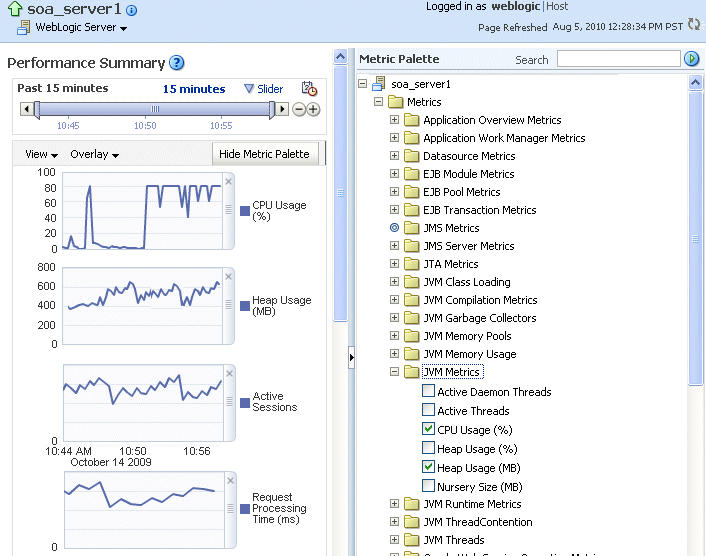
Select a metric to add it to the Performance Summary.
To overlay another target, click Overlay, and select the target. The target is added to the charts, so that you can view the performance of more than one target at a time, comparing their performance.
To customize the time frame shown by the charts, you can:
Click Slider to display a slider tool that lets you specify that more or less time is shown in the charts. For example, to show the past 10 minutes, instead of the past 15 minutes, slide the left slider control to the right until it displays the last 10 minutes.
Select the calendar and clock icon. Then, enter the Start Time and End Time. If there is no data available for those times, a confirmation message displays, explaining the timeline will be automatically adjusted to the time period for which the data is available.
You can also view the performance of a components, such as Oracle HTTP Server or Oracle SOA Suite. Navigate to the component and select Monitoring, then Performance Summary from the dynamic target menu.
Fusion Middleware Control provides a Topology Viewer for the farm. The Topology Viewer is a graphical representation of routing relationships across components and elements of the farm. You can easily determine how requests are routed across components. For example, you can see how requests are routed from Oracle Web Cache, to Oracle HTTP Server, to a Managed Server, to a data source.
Note:
To view relationships between Oracle WebLogic Server, Oracle Web Cache, and Oracle HTTP Server, each target must be running and show its status as Up.
The Topology Viewer enables you to easily monitor your Oracle Fusion Middleware environment. You can see which entities are up and which are down.
You can also print the topology.
To view the topology:
Click Topology, as shown in the following figure:

The Topology Viewer is displayed in a separate window.
To see information about a particular target, place your mouse over the target. To view additional information, click More.
The following shows the Topology Viewer window, with information about the Managed Server soa_server1:

With Topology Viewer, you can also:
Choose how to group the routing. From the View menu, you can choose to group by Middleware or by application.
Choose the types of nodes to show. From the Show Nodes menu, select the types of nodes, such as data sources.
View the targets by status. Click the green up arrow or the red down arrow at the top of the page. A list of the targets with the specified status is shown.
Search for a target within the topology. This makes it easier to find a target if you have many targets. Enter the name in the Find box, and click Find.
The Find results box is displayed. Click the target name to highlight the target. The topology is repositioned so you can see the target if it was not previously visible in the viewing area.
You can also specify criteria for the search. From Find, choose the one or more types of Status or one or more of Target Type, or both.
Hide or show the status or metrics. From Annotations, click Status or Metrics.
If you select Metrics, one key performance metric for the component is displayed. (You cannot change the metric that is displayed.)
Reposition the topology and change its orientation:
To change the orientation, from the Options menu, choose Layout, then Left to Right or Top Down.
To reposition the topology, click in the topology, but not on a target or route. Drag the topology to position it.
To change what is visible in the topology view, from the Options menu, choose Show/Hide Navigator. Then, drag the shaded section in the navigator window, which is located in the bottom right.
Navigate to the home page of a target. Right-click the target, and select Home.
Perform operations directly on the target by right-clicking. The right-click target menu is displayed. For example, from this menu, you can start or stop an Oracle WebLogic Server or view additional performance metrics.
View the routing relationships between components. For example, you can view the routing from Oracle Web Cache to Oracle HTTP Server to Oracle WebLogic Server. Clicking on the line between the two targets displays the URLs used.
From the Refresh dropdown, you can refresh manually, or you can enable automatically refreshing the status and metrics, every minute, every five minutes, or every thirty minutes. By default, the Topology Viewer refreshes the metrics every 5 minutes.
Notes:
If you use Mozilla Firefox, when you click a link or menu item in the Topology Viewer to navigate back to the main Fusion Middleware Control window, the main window does not always get focus. For example, if you right-click a target node and select View Log Messages from the target menu, the focus remains on the Topology Viewer window. (If you go back to the main window, the Log Messages page is correctly displayed.)
To workaround this problem, make the following change in Firefox:
From the Tools menu, select Options, and then Content. Click Advanced. In the Advanced JavaScript Settings dialog box, select Raise and lower windows.
If you use Internet Explorer, turn off the Always Open Popups in New Tab option.